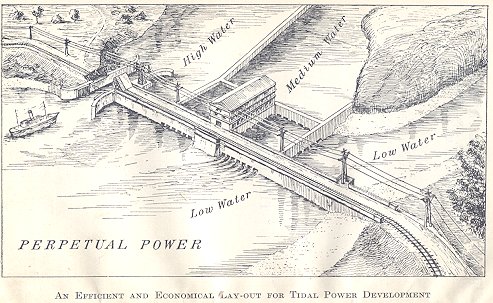Tidal Power, 1921
Today, solar power and lunar power. The University of Houston's College of Engineering presents this series about the machines that make our civilization run, and the people whose ingenuity created them.
Renewable energy is a term worth looking at. We can use direct solar energy to heat water or our homes. We can focus solar energy to supply steam boilers. We can build engines to take energy from the warm surface of the ocean and discharge it into the cold water below. We use solar cells to convert solar energy to electricity. Nature often does the work of converting heat into usable power for us, by moving water and wind around the planet. Thus windmills and hydroelectric plants deliver solar power.
We call such energy renewable only because the sun replaces what we use. No energy is truly renewable. Sooner or later, every source runs down, even the sun. It's just in comparison with our brief human lives, that it might as well be inexhaustible.
Another nearly inexhaustible source of energy is planetary kinetic energy. Every day the moon's gravitational pull lifts countless tons of water up into, say, the East River or the Bay of Fundy. When that water flows back out to sea, its energy dissipates and, if we don't use it, it's simply spent.
So where did that energy come from? It was taken from the moon's and Earth's kinetic energy. The tides slow us down. Each year on Earth is about half-a-second longer than the one before it. But, like the flow of solar energy, that consumption is present whether we claim it or not.
We might claim it in many ways. The most obvious is to catch sea water at high tide, then run it out through a turbine during low tide.

Still, every large energy system comes at a price. Fossil fuels soil the air. The problem of nuclear waste haunts us. Hydroelectric dams create huge reservoirs and pose a threat when they grow old. Modern windmills kill endangered birds as well as consuming real estate. So what price do we pay for tidal power?
It has the potential for picking up about a fiftieth of our energy consumption. That could be a great help, but never more than a help. Tidal power systems are potentially big and expen-sive, and they pose poorly understood threats to ocean ecosystems.
Tidal power (what I like to call lunar energy) is not new. Tidal mills were built in the eighteenth century when their major competition were windmills and water wheels. The tidal mills largely vanished once we had cheap steam engines.
I have a 1921 book on Tidal Power that describes systems we might use today. It discusses tidal variability and intermittency and treats the delicate business of placing tidal plants.
Power use in 1921 was only a thirtieth of today's consumption. Even then, tidal power clearly couldn't have been enough to replace the use of coal. Yet tidal power was going to waste then, as it goes to waste today. The author of this old book might as well be writing for us when he sums up the situation by quoting Cecil Rhodes' dying sigh, "So little done, so much to do."
I'm John Lienhard, at the University of Houston, where we're interested in the way inventive minds work.
(Theme music)
Struben, A. M. A., Tidal Power. London: Sir Isaac Pitman & Sons, Ltd., 1921.

The frontispiece of Struben's book